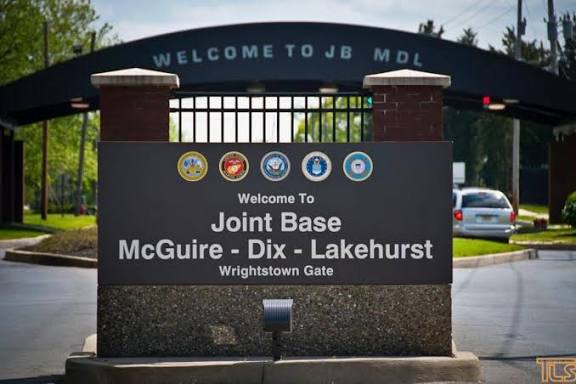Joint Base McGuire‑Dix‑Lakehurst: Lockdown at JBMDL on High Alert,5 Shocking Facts

During a training exercise, a lockdown was lifted in the joint base McGir-Dix-Lekehrest after the witnesses heard the sound of bullets. Today we will discuss about Joint Base McGuire‑Dix‑Lakehurst: Lockdown at JBMDL on High Alert,5 Shocking Facts
Joint Base McGuire‑Dix‑Lakehurst: Lockdown at JBMDL on High Alert,5 Shocking Facts
On September 30, 2025, Joint Base McGuire-Dix-Lakehurst (JBMDL) in New Jersey was thrust into the spotlight when it was placed on lockdown following reports of an active shooter. The announcement of a “lockdown” at such a sprawling, tri-service military installation sent shockwaves through media and the surrounding community. What followed was an intense hour of uncertainty, which ended with an “all clear” but raised profound questions about base security, protocol, and the risks facing modern military installations.
Below is a deep dive into the event, its implications, and 5 shocking facts you should know about JBMDL’s vulnerabilities and operations.
1. What Happened: Timeline of the Lockdown

-
At 10:58 a.m., reports of an active shooter at JBMDL triggered emergency protocols.
-
Personnel across the base were ordered to lockdown. Those outside were instructed to take cover until further notice.
-
Law enforcement and base security forces mobilized immediately to investigate.
-
After about 59 minutes, at 11:57 a.m., the base issued an “ALL CLEAR.”
-
Officials confirmed that no credible threat or active shooter was located. The report turned out to be unfounded.
-
According to media reports, the confusion may have originated from a training exercise in which gunshots were heard, triggering misinterpretation.
This rapid escalation and rapid resolution underscore both the strengths and the challenges of security operations in large, multifaceted military bases.
2. Why JBMDL Matters — A Tri-Service Installation with Strategic Role
JBMDL is not your ordinary military base. Its complexity and importance make it a high-value target and a uniquely challenging security environment:
-
Tri-Service Integration: JBMDL is the only joint base in the U.S. that integrates Air Force, Army, and Navy operations under one umbrella.
-
Large Population and Footprint: The base houses tens of thousands of military personnel, civilian employees, contractors, and family members.
-
Varied Mission Sets: The base supports airlift, air refueling, global power projection, and logistical operations.
-
Overlap with Civilian and Local Jurisdictions: Because the base spans Burlington and Ocean Counties, coordination with local law enforcement is essential.
-
Embedded Prison Facility: Within the JBMDL perimeter is FCI Fort Dix, a federal prison. That adds a layer of complexity, including concerns about contraband, infiltration, and drone incursions.
Because of these factors, JBMDL operates under conditions of constant vigilance. A single false alarm, like the recent one, can ripple broadly—disrupting operations, instilling fear, and revealing gaps in situational awareness.
3. 5 Shocking Facts You Didn’t Know About JBMDL & Its Security
Here are 5 lesser-known but striking facts about JBMDL, especially in light of the recent lockdown:
Fact 1: Drone Smuggling Attempts Over the Prison
Numerous drone incursions have been recorded near JBMDL’s airspace, aimed at smuggling contraband—such as drugs, cell phones, tobacco—into the FCI Fort Dix prison located within base boundaries.
The base has had to adopt countermeasures and closely collaborate with local law enforcement to intercept or recover rogue UAVs.
These incursions underscore how even a “secure” facility is vulnerable to aerial threats hidden in civilian airspace.
Fact 2: Pilots Targeted by Ground Lasers
As disturbing as drone smuggling, base officials have reported ground-based lasers fired toward aircraft associated with JBMDL.
Between December 2023 and late 2024, multiple incidents were logged—enough that one pilot required medical attention.
This kind of threat is especially pernicious because it can momentarily blind or disorient a pilot during critical flight phases.
Fact 3: Rapid Response Protocols Prevented Escalation
In the recent lockdown, the base was able to mobilize security forces and law enforcement, isolate areas of concern, and issue an “all clear” in under an hour.
That demonstrates how seriously military installations invest in incident response drills, layered security, and communication protocols.
But it also reveals how thin the margin for error may be—had the threat been real, every second would count.
Fact 4: Training Exercises Can Trigger Real Alarm
In this incident, reports suggest the gunshots that triggered the lockdown were part of a training exercise on the McGuire section of the base.
This is a known challenge in military security: distinguishing between live fire drills and actual hostile actions, especially when local residents or off-base observers hear or interpret gunfire.
It’s a fine line—too many false alarms undermine credibility; too few precautions risk disaster.
Fact 5: The Base Is a Massive Local Economic Engine—and Vulnerability
JBMDL is one of New Jersey’s largest employers.
Any disruption—especially that which demands lockdowns or restricts movement—impacts local businesses, schools, and civilian communities.
That economic footprint increases pressure on authorities to respond swiftly and transparently, but also makes the base a high-profile target for symbolic or disruptive attacks.
4. Implications & Key Lessons from the Lockdown
The recent lockdown at JBMDL, small in duration but large in symbolic weight, teaches several important lessons:
4.1. Awareness vs. Overreaction: The Balance of Security
Military bases must remain on guard—but also avoid panic. Rapid, accurate threat assessment is critical. In this case, the system worked: the base locked down, assessed, and cleared the situation within an hour. But the risk of false alarms causing unnecessary stress or operational disruption is always present.
4.2. Layered Security Must Be Robust Yet Flexible
JBMDL’s security relies on physical barriers, personnel, sensors, interagency coordination, intelligence, and rules of engagement (ROE). No single layer suffices. As drone incursions and laser attacks show, threats come from unexpected vectors.
4.3. Civil-Military Integration Is Key
Because JBMDL interfaces with civilian communities and jurisdictions, communication, coordination, and trust with local law enforcement, emergency services, and municipal governments is vital. During the lockdown, local agencies aided response efforts.
4.4. Psychological Impact & Credibility
Even when a lockdown ends in a “false alarm,” the psychological impact on personnel, civilians, and nearby residents lingers. Trust in command, situational awareness, and clarity of information become essential. Rumors and misinformation can add chaos.
4.5. Evolving Threats Demand Constant Adaptation
From drones to laser pointers to cybersecurity to insider threats, military bases are under pressure to stay ahead. The recent incident underscores the dynamic nature of risk and the need for continuous review of security doctrine, technology, training, and communication.
5. Recommendations & Best Practices for Future Readiness
Drawing from the incident at JBMDL and comparable events, here are some recommendations for military installations (and stakeholders) to bolster readiness and resilience:
5.1. Simulated Drills with Realistic Stressors
Run tabletop and live exercises that include false start scenarios, stress-induced decision making, civilian overhearings, media leaks, and multiagency coordination. Ensuring personnel can distinguish between drills and real threats is critical.
5.2. Advanced Sensor Fusion & Aerial Threat Detection
Deploy radar, lidar, RF detectors, acoustic gunshot sensors, and counter-UAV systems to provide early warning and automatic classification of threats. For example, distinguishing training ordinance from hostile fire may be aided by trajectory analysis, round type detection, and mapping.
5.3. Strict Airspace Enforcement
Maintain and enforce no-fly zones or restricted zones over critical military areas. Unauthorized drones should be tracked, identified, and interdicted. JBMDL’s experience with contraband drones into its prison illustrates how serious this threat can be.
5.4. Rapid Multiagency Communication Channels
Set up real-time communication protocols among base security, local police, emergency medical services, fire, and civilian authorities. Secure data sharing (video feeds, personnel location, threat intel) is crucial during an unfolding event.
5.5. Transparent and Timely Messaging
When a lockdown occurs, clear, timely communication to personnel and the public is essential to control confusion or misinformation. Use base social media, internal alert systems, and liaison with local media. The “ALL CLEAR” messaging at JBMDL was prominent.
5.6. Psychological & After-Action Support
After an event (real or false alarm), provide counseling, debriefings, and lessons-learned sessions. Recognizing the stress and reinforcing confidence is part of resilience.
6. The Bigger Picture: Military Base Security in the 21st Century
JBMDL’s lockdown incident is not an isolated curiosity but part of a broader narrative of how military bases adapt to evolving threats.
-
Nontraditional vectors such as drones, cyber intrusion, insider actors, and “hybrid warfare” tactics are forcing rethinking of classic base defense.
-
Public perception and media pressure require quicker transparency and better information control.
-
Resource constraints mean bases must optimize, upgrade selectively, and train smarter.
-
Interoperability and partnerships with civilian agencies, local governments, tech firms, and international security bodies are more critical than ever.
As bases like JBMDL serve multiple services and mission domains, their vulnerability surface is broader. Lockdowns or alarms—even false ones—are part of the modern security reality.
7. Conclusion: Vigilance, Transparency, and Adaptation
The lockdown at Joint Base McGuire-Dix-Lakehurst may have lasted less than an hour, and no real threat was found. But its resonance is far greater. It exposed the inherent tensions in securing a massive, multifaceted military hub: the need for constant vigilance, yet the necessity of discernment and control.
The 5 shocking facts around JBMDL—the drone incursions, laser threats, training-triggered alarms, economic footprint, and rapid-response success—all form a mosaic of modern base security challenges. As threats evolve, JBMDL and similar installations must stay agile, transparent, and resilient.
How useful was this post?
Click on a star to rate it!
Average rating 0 / 5. Vote count: 0
No votes so far! Be the first to rate this post.
About the Author
usa5911.com
Administrator
Hi, I’m Gurdeep Singh, a professional content writer from India with over 3 years of experience in the field. I specialize in covering U.S. politics, delivering timely and engaging content tailored specifically for an American audience. Along with my dedicated team, we track and report on all the latest political trends, news, and in-depth analysis shaping the United States today. Our goal is to provide clear, factual, and compelling content that keeps readers informed and engaged with the ever-changing political landscape.




